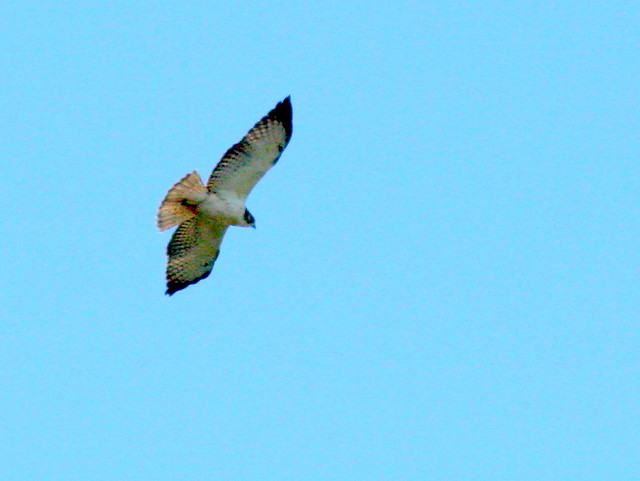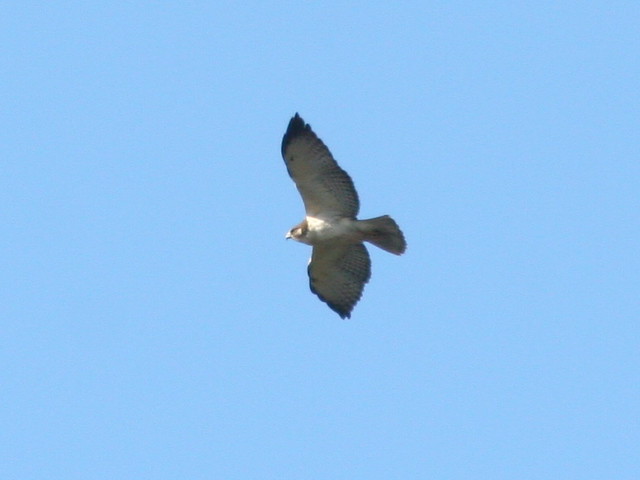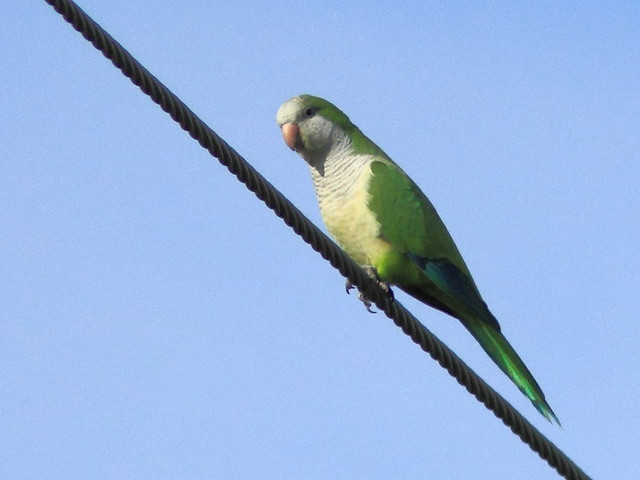Posted by: Ken @ 6:42 pm
I’ve tried to limit my blog posts to once per week, but there is a backlog developing, so let me tell about today’s experience.
At about 9:45 AM this morning we checked on the welfare of the local pair of Bald Eagles at their nest, in Pembroke Pines, Florida near our home. The oldest chick is about 29 days old. We have only seen one eaglet so far, and today was no exception. When we arrived, the female was on the nest and roosting high, which we think meant that she was expecting a food drop.

After about 25 minutes an Osprey flew low over the nest.

Still no sign of any eaglets. After watching about 50 minutes, we were ready to quit when the male flew in from the back of the nest with unidentified prey. The male then roosted on the tall pine just west of the nest while the female tore at the prey and fed the young.

I was busy photographing the roosting eagle when Mary Lou got a good look at the eaglet, quite high above the nest rim. I only got a few shots of the top of its head.

Again, only one chick was evident. Here is another view.

While the male was still roosting, an unusual raptor showed up in a flock of Black Vultures that were circling above the nest tree. Its very dark and heavy body, pointed and slightly uplifted wing tips, bulging secondary flight feathers that gave a rounded look to the trailing edge of the mid-wings, plus a sharp narrowing of the wings near the body suggested it was a Buteo, probably a dark morph of the Short-tailed Hawk.

I could not confirm the ID until I looked at the rather poor and distant images on the computer. They showed a bright yellow cere and light areas at the base of the outer primaries, consistent with Short-tailed Hawk. This was the first time I’ve seen this species over the nest, though it does occur in the wetlands near our home about 1 1/2 miles to the SE. Short-tailed Hawks occur in both a dark and a light morph. The former is said to be more common in South Florida.

When I first saw this Short-tailed Hawk, its red tail made me think it was a Red-tailed Hawk.
However, there is no red pigment in its tail, and the redness is attributed to scattered or diffracted light passing through the structure of the tail feathers. Here is another view.
We also had several Monk Parakeets roosting on wires near the nest.
Visit this site for a searchable archive of earlier ROSYFINCH RAMBLINGS blog posts
















February 14th, 2012 at 3:15 pm Another great tour!! Boom & Gary of the Vermilon River, Canada.
February 14th, 2012 at 3:52 pm Beautiful shots of the eagle! Love the hawks, too.
February 14th, 2012 at 4:31 pm Hi Ken, it must be cool to be able to see the eagles nest and follow their progress. Neat sightings of the hawk, it would be a new one for me. Great post and photos.
February 14th, 2012 at 4:33 pm Wonderful images Ken… I am in awe of these beautiful birds..
February 14th, 2012 at 6:01 pm Your ID of the hawks is very interesting but the eagle photos are really great! The one of the adult on the nest with its foot up to its beak is amazing!
February 14th, 2012 at 7:19 pm Fabulous set of photos, especially the eagle.
February 14th, 2012 at 7:58 pm What magnificent birds those eagles are Ken. Great shots of them.
February 14th, 2012 at 8:30 pm Beautiful photos!
February 15th, 2012 at 10:55 am Great collection of photos!
February 15th, 2012 at 1:50 pm How fortunate you are to be this close to so many different species of beautiful Raptors!
February 15th, 2012 at 11:31 pm Fabulous shots of the Eagles and nest!
February 16th, 2012 at 10:20 am Great stuff Ken! Love that dark morph and the baldies are, of course, off the hook!